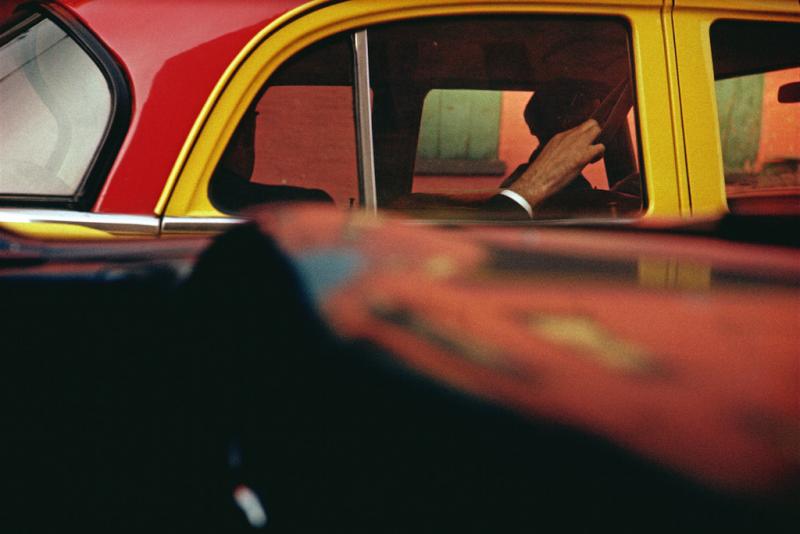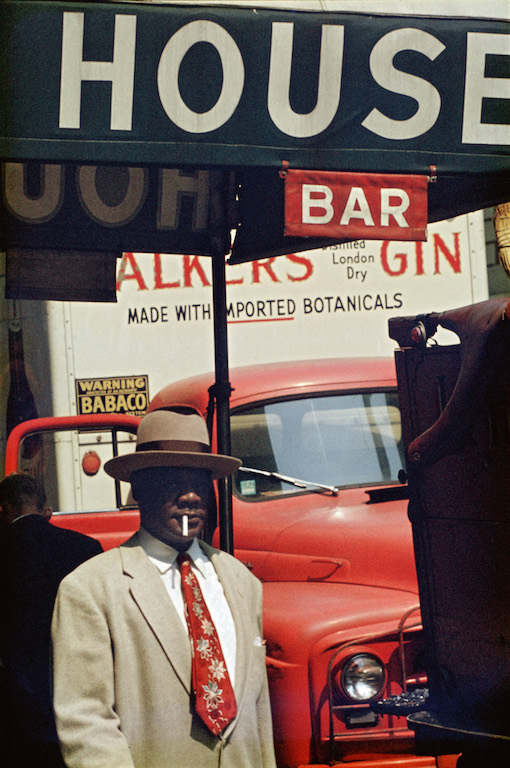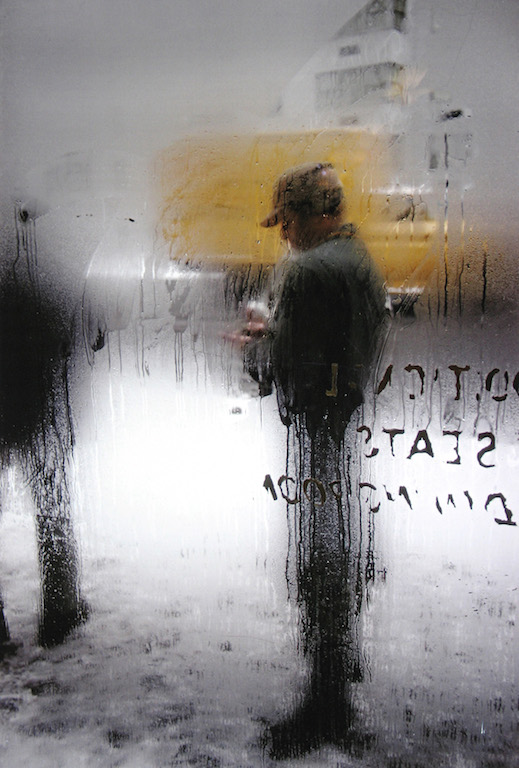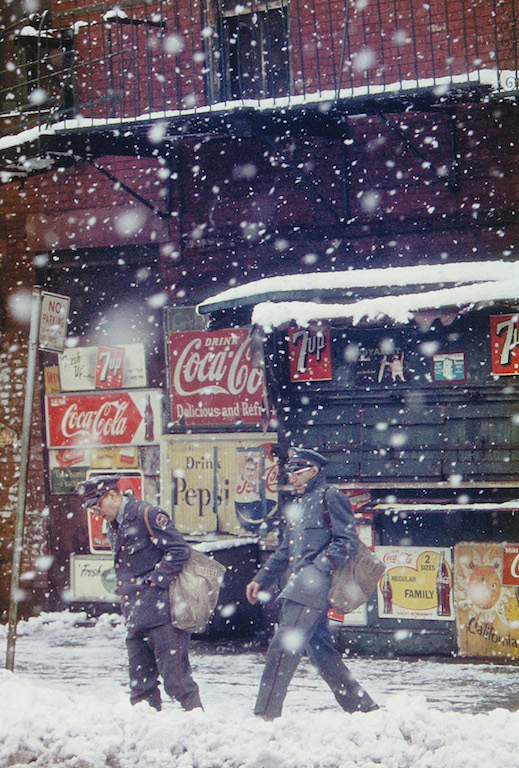Saul Leiter, Photographers' Gallery | reviews, news & interviews
Saul Leiter, Photographers' Gallery
Saul Leiter, Photographers' Gallery
The pioneer of colour photography you have yet to hear of

One of the great joys of being a critic is discovering someone remarkable you’ve never heard of before. By the time he died in 2013 aged 90, the American photographer Saul Leiter had gained a degree of recognition, but it had been slow in coming and only now is his work gaining an international reputation.
His contemporary, Robert Frank, became internationally famous – mainly as the result of his seminal book The Americans, 1958; but while he was given a solo exhibition at the Museum of Modern Art (MoMA), New York in 1962, Leiter had to make do with inclusion in group shows. Both specialised in street photography, but whereas Frank shot his desolate pictures in black and white, the only form of documentary photography taken seriously at the time, Leiter revelled in the beauty of colour, which was dismissed by most practitioners as frivolous, gaudy and fit only for amateurs.
 I remember, in the mid-1970s, having violent rows with a photojournalist at the London College of Printing (now the London College of Communication) where I taught in the photography department. He argued that only black and white film could capture “the truth”: all else was heresy. When I remarked that his position was hard to justify since we see in colour, he nearly died of a heart attack, such was the vehemence of his belief.
I remember, in the mid-1970s, having violent rows with a photojournalist at the London College of Printing (now the London College of Communication) where I taught in the photography department. He argued that only black and white film could capture “the truth”: all else was heresy. When I remarked that his position was hard to justify since we see in colour, he nearly died of a heart attack, such was the vehemence of his belief.
And such was the prejudice that Leiter was up against. Thankfully, though, it didn’t deter him. He saw himself, first and foremost, as an artist working in film and paint and, although the paintings on show are rather slight and whimsical, his painterly eye produced photographs of rare beauty and subtlety. While Frank’s pictures of urban alienation have immediate, hard-hitting impact, Leiter’s images are so complex they often take a while to decipher – perhaps another reason for his slow rise to fame.
Take Harlem, 1960 (pictured above right) for instance. A black man in a panama hat and beige jacket smokes a cigarette as he walks under the black awning outside a bar. There’s nothing to this chance encounter with a passer-by, except for an amazing synchronicity of colour. The man’s beige jacket matches the lettering on the awning announcing HOUSE, while his tie matches the red cab of the lorry parked behind him and the lettering on the vehicle advertising Walker’s Gin. A man in a black coat walking the other way frames the left side of the picture while a black dustbin frames the right side. The coup de grâce is the beige and red sign overhead that reads BAR and completes the colour composition.
If this were a painting by Whistler, the image might be called Harmony in Beige, White, Red and Black and it would have been artfully contrived. Leiter’s photograph, on the other hand, was completely unplanned. “I’ve never had a system or a project,” he insisted. “I don’t go out looking for things. I wander around with my camera, like a flâneur.” The paradox is that he responded to “unimportant things” spotted en passant, yet the viewer often has to spend time unravelling this split second of information.
 Leiter loved reflections, odd perspectives and things framed by or seen through windows, such as the passenger glimpsed through the window of a passing taxi (main picture). He was especially drawn to the visual effects created by inclement weather, such as rain or snow, describing his endeavour as “a search for beauty... Photography teaches you to look.” And looking is often the main topic. “I like it when one is uncertain what one sees. When we do not know why the photographer has taken a picture and when we do do not know why we are looking at it, all of a sudden we discover something...”
Leiter loved reflections, odd perspectives and things framed by or seen through windows, such as the passenger glimpsed through the window of a passing taxi (main picture). He was especially drawn to the visual effects created by inclement weather, such as rain or snow, describing his endeavour as “a search for beauty... Photography teaches you to look.” And looking is often the main topic. “I like it when one is uncertain what one sees. When we do not know why the photographer has taken a picture and when we do do not know why we are looking at it, all of a sudden we discover something...”
Green Light Against Grey, from the1950s, shows a green traffic signal feebly glimmering through a thick blanket of snow. Shot through a snow-sodden window, Snow, 1960, (pictured above left) features a woman whose upper body is an out of focus blur, while her legs appear to be dissolving into rivulets of damp. The only elements in focus are some words scrawled in the wet of the shop window. Writing is similarly important in Postmen, 1952, (pictured below right). Festooning the wall behind two postmen braving a snowstorm are Coca Cola, Pepsi and 7 Up signs that seem to offer the promise of warmer times ahead.
Leiter was friends with abstract expressionist painters such as Willem de Kooning and some of his photographs are as abstract as their canvases. Purple Umbrella, dating from the 1950s, is a blurry view of a wet road framed by the curves of a brightly coloured umbrella. A black shape covers two-thirds of Canopy, 1957; beneath the blind, one glimpses the huddled silhouettes of people battling their way through a blizzard on the street outside. In Kutztown, 1948, a cluster of feet is all that’s visible of the crowd standing the other side of a barrier among discarded rubbish and deflated balloons.
 William Eggleston is usually given credit for discovering the full potential of colour photography. A generation younger than Leiter, he was accorded a MoMA retrospective as early as 1965. It must have been galling for Leiter who had begun exploring colour in 1948, often using out of date film stock for the subtlety and unpredictability of the results; but he suffered the fate of many pioneers, who are ahead of their time – to be denigrated or overlooked. Far from being bitter, though, he remained modest and good-natured until the end, by which time he had been honoured with a retrospective at the Fondation Henri Cartier-Bresson in Paris. Now his influence is growing apace; film director Todd Haynes, for example, cites Leiter as the inspiration behind recent films such as Carol, which won unanimous applause for the beauty of its camerawork.
William Eggleston is usually given credit for discovering the full potential of colour photography. A generation younger than Leiter, he was accorded a MoMA retrospective as early as 1965. It must have been galling for Leiter who had begun exploring colour in 1948, often using out of date film stock for the subtlety and unpredictability of the results; but he suffered the fate of many pioneers, who are ahead of their time – to be denigrated or overlooked. Far from being bitter, though, he remained modest and good-natured until the end, by which time he had been honoured with a retrospective at the Fondation Henri Cartier-Bresson in Paris. Now his influence is growing apace; film director Todd Haynes, for example, cites Leiter as the inspiration behind recent films such as Carol, which won unanimous applause for the beauty of its camerawork.
rating
Explore topics
Share this article
The future of Arts Journalism
You can stop theartsdesk.com closing!
We urgently need financing to survive. Our fundraising drive has thus far raised £33,000 but we need to reach £100,000 or we will be forced to close. Please contribute here: https://gofund.me/c3f6033d
And if you can forward this information to anyone who might assist, we’d be grateful.

Subscribe to theartsdesk.com
Thank you for continuing to read our work on theartsdesk.com. For unlimited access to every article in its entirety, including our archive of more than 15,000 pieces, we're asking for £5 per month or £40 per year. We feel it's a very good deal, and hope you do too.
To take a subscription now simply click here.
And if you're looking for that extra gift for a friend or family member, why not treat them to a theartsdesk.com gift subscription?
more Visual arts
 Help to give theartsdesk a future!
Support our GoFundMe appeal
Help to give theartsdesk a future!
Support our GoFundMe appeal
 Do Ho Suh: Walk the House, Tate Modern review - memories are made of this
Home sweet home preserved as exquisite replicas
Do Ho Suh: Walk the House, Tate Modern review - memories are made of this
Home sweet home preserved as exquisite replicas
 Ed Atkins, Tate Britain review - hiding behind computer generated doppelgängers
Emotions too raw to explore
Ed Atkins, Tate Britain review - hiding behind computer generated doppelgängers
Emotions too raw to explore
 Echoes: Stone Circles, Community and Heritage, Stonehenge Visitor Centre review - young photographers explore ancient resonances
The ancient monument opens its first exhibition of new photography
Echoes: Stone Circles, Community and Heritage, Stonehenge Visitor Centre review - young photographers explore ancient resonances
The ancient monument opens its first exhibition of new photography
 Hylozoic/Desires: Salt Cosmologies, Somerset House and The Hedge of Halomancy, Tate Britain review - the power of white powder
A strong message diluted by space and time
Hylozoic/Desires: Salt Cosmologies, Somerset House and The Hedge of Halomancy, Tate Britain review - the power of white powder
A strong message diluted by space and time
 Mickalene Thomas, All About Love, Hayward Gallery review - all that glitters
The shock of the glue: rhinestones to the ready
Mickalene Thomas, All About Love, Hayward Gallery review - all that glitters
The shock of the glue: rhinestones to the ready
 Interview: Polar photographer Sebastian Copeland talks about the dramatic changes in the Arctic
An ominous shift has come with dark patches appearing on the Greenland ice sheet
Interview: Polar photographer Sebastian Copeland talks about the dramatic changes in the Arctic
An ominous shift has come with dark patches appearing on the Greenland ice sheet
 Donald Rodney: Visceral Canker, Whitechapel Gallery review - absence made powerfully present
Illness as a drive to creativity
Donald Rodney: Visceral Canker, Whitechapel Gallery review - absence made powerfully present
Illness as a drive to creativity
 Noah Davis, Barbican review - the ordinary made strangely compelling
A voice from the margins
Noah Davis, Barbican review - the ordinary made strangely compelling
A voice from the margins
 Best of 2024: Visual Arts
A great year for women artists
Best of 2024: Visual Arts
A great year for women artists
 Electric Dreams: Art and Technology Before the Internet, Tate Modern review - an exhaustive and exhausting show
Flashing lights, beeps and buzzes are diverting, but quickly pall
Electric Dreams: Art and Technology Before the Internet, Tate Modern review - an exhaustive and exhausting show
Flashing lights, beeps and buzzes are diverting, but quickly pall
 ARK: United States V by Laurie Anderson, Aviva Studios, Manchester review - a vessel for the thoughts and imaginings of a lifetime
Despite anticipating disaster, this mesmerising voyage is full of hope
ARK: United States V by Laurie Anderson, Aviva Studios, Manchester review - a vessel for the thoughts and imaginings of a lifetime
Despite anticipating disaster, this mesmerising voyage is full of hope

Add comment